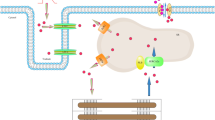Abstract
The irreversible loss of activity of the sarcolemma-localized β-receptor-adenylyl cyclase system (β-RAS) in myocardial ischemia is a well documented phenomenon. Alterations in the sarcolemma (SL) induced by reactive O2 species could be responsible for this loss. Therefore the influence of oxidation of SH-groups and lipid peroxidation induced by Fe2+/Vit. C on the β-RAS activity was studied. During incubation of SL with Fe2+/Vit. C a transient enhancement followed by a continuous loss of the β-RAS activity (isoprenaline-, NaF-, Gpp(NH)p-, forskolin-stimulated and basal activity) was observed. In contrast there occurred a continuous loss of SH-groups and lipid peroxidation, beginning immediately after the start of incubation. Loss of SH-groups and lipid peroxidation as well as changes in the β-RAS did not take place in the presence of the antioxidant t-Butyl-4-hydroxyanisole (BHA) or the Fe2+-chelator EGTA. In view of the known ischemia-induced formation of reactive O2 species our results show that these powerful oxidants could contribute to the modulation of the β-RAS during myocardial ischemia.
Similar content being viewed by others
Abbreviations
- BHA:
-
t-Butyl-4-Hydroxyanisole
- DTNB:
-
5,5′-Dithio-bis-(2-nitrobenzoic acid)
- DTT:
-
Dithiothreitol
- EGTA:
-
Ethyleneglycol-bis-(2-amino-ethylether)-N,N,N,N′-Tetraacetic Acid
- Gpp(NH)p:
-
Guanylylimidodiphosphate
- HSA:
-
Human Serum Albumine
- PMSF:
-
Phenylmethylsulfonyl Fluoride
- β-RAS:
-
β-Receptor-Adenylyl cyclase System
- SDS:
-
Sodium Dodecylsulfate
- TRIS:
-
Tris(hydroxymethyl)-aminomethane
- SL:
-
Sarcolemma
References
Levey GS: Solubilization of myocardial adenyl cyclase: Loss of hormone responsiveness and activation by phospholipids. Ann New York Acad Sci 185: 449–457, 1971
Levey GS: Phospholipids, adenylate cyclase, and heart. J Mol Cell Cardiol 4: 283–285, 1972
Sinha AK, Shattil SJ, Colman RW: Cyclic AMP metabolism in cholesterol-rich platelets. J Biol Chem 252: 3310–3314, 1977
Brivio-Haugland RP, Louis SL, Musch K, Waldeck N, Williams MA: Liver plasma membranes from essential fatty acid-deficient rats. Isolation, fatty acid composition, and activities of 5′-nucleotidase, ATPase and adenylate cyclase. Biochim Biophys Acta 433: 150–163, 1976
Will-Shahab L, Krause EG, Bartel S, Schulze W, Küttner I: Reversible inhibition of adenylate cyclase activity in the ischemic myocardium. J Cardiovasc Pharmacol 7 (suppl 3): 23–27, 1985
Zweier JL: Measurement of superoxide-derived free radicals in the reperfused heart. J Biol Chem 263: 1353–1357, 1988
Baker JE, Felix CC, Olinger GN, Kalyanaraman B: Myocardial ischemia and reperfusion: Direct evidence for free radical generation by electron spin resonance spectroscopy. Proc Natl Acad Sci USA 85: 2786–2789, 1988
Röth E, Törok B, Zsoldos T, Matkovics B: Lipid peroxidation and scavenger mechanism in experimentally induced heart infarcts. Basic Res Cardiol 80: 530–536, 1986
Schimke I, Kahl PE, Romaniuk P, Papies B: Konzentration Thiobarbitursäure-reaktiver Substanzen (TBARS) im Serum nach Myokardinfarkt. Klin Wochenschr 64: 1237–1239, 1986
Kühl PW: A redox cycling model for the action of β-adrenoceptor agonists. Experientia 41: 1118–1122, 1985
Vetter R, Haase H, Will H: Potentiating effect of calmodulin and catalytic subunit of cyclic AMP-dependent protein kinase on ATP-dependent calcium ion transport by cardiac sarcolemma. FEBS Lett 148: 326–333, 1982
Ohkawa H, Ohishi N, Yagi K: Assay for lipid peroxidation in animal tissues by thiobarbituric acid reaction. Anal Biochem 95: 351–358, 1978
Habeeb AFS: Reaction of protein sulfhydryl groups with Ellman's reagent. Meth Enzymol 25: 457–464, 1972
Ramachandran JA: A new simple method for separation of adenosine 3′,5′ cyclic monophosphate from other nucleotides and its use in the assay of adenylate cyclase. Anal Biochem 43: 227–236, 1971
Lowry OH, Rosebrough NJ, Farr AI, Randall RJ: Protein measurement with the folin phenol reagent. J Biol Chem 193: 265–271, 1951
Chambers DE, Parks DA, Patterson G, Roy R, McCord JM, Yoshida S, Parmley LP, Downey JM: Xanthine oxidase as a source of free radical damage in myocardial ischemia. J Mol Cell Cardiol 17: 145–152, 1985
Schimke I, Schimke E, Papies B, Moritz V: Importance of the antioxidative potential for free radical induced heart damage. Biomed Biochim Acta 46 (suppl): 576–579, 1987
Kramer JH, Mak IT, Weglicki WB: Differential sensitivity of canine cardiac sarcolemmal and microsomal enzymes to inhibition by free radical-induced lipid peroxidation. Circul Res 55: 120–124, 1984
Buege J, Aust SD: Microsomal lipid peroxidation. Meth Enzymol 53: 302–310, 1978
Ursini F, Maiorino M, Valente M, Ferri I, Gregolin G: Purification from pig liver of a protein which protects liposomes and biomembranes from peroxidative degradation and exhibits glutathione peroxidase activity on phosphatidylcholine hydroperoxides. Biochem Biophys Acta 710: 197–211, 1982
Haenen GRMM, Veerman M, Bast A: Reduction of β-adrenoceptor function by oxidative stress in the heart. Free Rad Biol Med 9: 279–288, 1990
Heikkila RE: Ascorbate-induced lipid peroxidation and the binding of (3H)-dihydroalprenolol. Eur J Pharmacol 93: 79–85, 1983
Palmer GC: Free radicals generated by xanthine oxidase-hypoxanthine damage adenylate cyclase and ATPase in gerbil cerebral cortex. Metabolic Brain Disease 2: 243–257, 1987
Baba A, Lee E, Ohta A, Tatsuno T, Iwata H: Activation of adenylate cyclase of rat brain by lipid peroxidation. J Biol Chem 256: 3679–3684, 1981
Paradisi L, Parangini C, Parola M, Barreva G, Dianzani MU: Effects of 4-hydroxynonenal on adenylate cyclase and 5′-nucleotidase activities in rat liver plasma membranes. Chem-Biol Interactions 53: 209–217, 1985
Author information
Authors and Affiliations
Rights and permissions
About this article
Cite this article
Schimke, I., Haberland, A., Will-Shahab, L. et al. In vitro effects of reactive O2 species on the β-receptor-adenylyl cyclase system. Mol Cell Biochem 110, 41–46 (1992). https://doi.org/10.1007/BF02385004
Received:
Accepted:
Issue Date:
DOI: https://doi.org/10.1007/BF02385004




